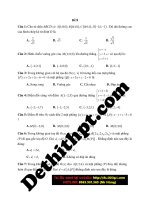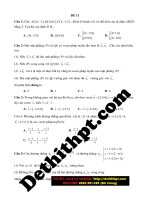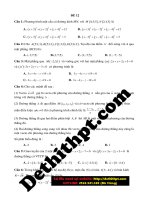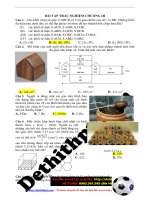Đề 37 image marked image marked
Bạn đang xem bản rút gọn của tài liệu. Xem và tải ngay bản đầy đủ của tài liệu tại đây (1.25 MB, 6 trang )
Exercise 37:
Read the following passage and mark the letter A, B, C or D to indicate the correct answer to each
of the questions.
Line
5
Aspirin's origins go back at least as early as 1758. In that year, Englishman
Edward Stone noticed a distinctive bitter flvor in the bark of the willow tree. To Stone,
this particular bark seem to have much in common with "Peruvian Bark", which had
been used medicinally since the 1640s to bring down fevers and to treat malaria, stone
decided to test the effectiveness of the willow bark. He obtained some, pulverized it
into tiny pieces, and conducted experiments on its properties. His tests demonstrated
that this pulverized willow bark was effective both in reducing high temperatures and
in relieving aches and pains. In 1763, stone presented his tiding to the British Royal
Society.
10
Several decades later, further studies on the medicinal value of the willow bark
were being conducted by two Italian scientists. These chemists, Brugnatelli and
Fontana, determined that the active chemical that was responsible for the medicinal
characteristics in the willow bark was the chemical salicin, which is the active
ingredient of today's aspirin.
15
The name "aspirin" is the trade name of the drug based on the chemical salicin,
properly known as acetylsalicylic acid.The trade name "aspirin" was invented for the
drug in the 1890s by the Bayer Drug Company in Germany. The fist bottles of aspirin
actually went on sale to the publicjust prior to the turn of the century, in 1899.
QUESTION
Question 1: According to the passage, aspirin originated ______.
A. no later than 1758
B. sometime after 1758
C. definitely sometime in 1758
D. no earlier than 1758
Đăng ký file Word tại link sau
/>
Question 2: It can be inferred from the passage that Peruvian Bark_______.
A. caused fevers
Trang 1
B. was ineffective in treating malaria
C. was described to the British Royal Society by Stone
D. was in use prior to aspirin
Question 3: The pronoun "it" in refers to _____.
A. malaria
B. willow bark
C. effectiveness
D. the British Royal Society
Question 4: The word "properties" in could best be replaced by_____.
A. ownership
B. body
C. characteristics
D. materials
Question 5: What did the willow bark look like after stone prepared it for his experiments?
A. It was in large chunks.
B. It was a thick liquid.
C. It was a rough powder.
D. It was in strips of bark.
Question 6: The Italian chemists mentioned in the passage most probably conducted their studies on
willow bark ________.
A. in the 1750s
B. in the 1760s
C. in the 1770s
D. in the 1780s
Question 7: What is true about Brugnatelli and Fontana?
A. They were from Italy.
B.They added a chemical to the willow bark,
C. They conducted studies on the willow bark.
D. They were medical doctors.
Question 8: The expression "prior to" in could best be replaced by _________.
A. at
B. before
C. during
D. after
Question 9: The word "turn" in could best be replaced by_______.
A. spin
B. corner
C. change
D. reversal
Question 10: Where in the passage does the author name the scientific compound that makes up aspirin?
A. lines 2-4
B. lines 7
C. lines 9-10
D. lines 13-14
GIẢI CHI TIẾT
Trang 2
Question 1: According to the passage, aspirin originated ________.
A. no later than 1758
B. sometime after 1758
C. definitely sometime in 1758
D. no earlier than 1758
Dịch nghĩa: Theo như đoạn văn, aspirin xuất hiện từ _________.
A. không muộn hơn 1758
B. một thời gian sau 1758
C. chắc chắn vào 1758
D. không sớm hơn 1758
Giải thích: đọc câu đầu tiên của bài: "Aspirin's origins go back at least as early as 1758" (Sự xuất hiện
của thuốc kháng sinh Aspirin muộn nhất là khoảng 1758)
Question 2: It can be inferred from the passage that Peruvian Bark_______.
A. caused fevers
B. was ineffective in treating malaria
C. was described to the British Royal Society by Stone
D. was in use prior to aspirin
Dịch nghĩa: Có thể rút ra từ đoạn văn rằng vỏ cây canh-ki-na _______.
A. gây ra bệnh sốt
B. không có tác dụng trong việc chữa bệnh sốt rét
C. được giới thiệu tới Cộng đồng Hoàng gia Anh bởi Stone
D. được sử dụng trước Aspirin
Giải thích: "To Stone, this particular bark seemed to have much in common with "Peruvian Bark",
which had been used medicinally since the 1640s to bring down fevers and to treat malaria" (Theo
ông Stone, loại vỏ cây đặc biệt này có vẻ như giống với vỏ canh-ki-na, loại thực vật đã được sử dụng như
là một loại thuốc từ những năm 1640 để hạ sốt và chữa bệnh sốt rét)
Question 3: The pronoun "it" in refers to _____.
A. malaria
B. willow bark
C. effectiveness
D. the British Royal Society
Dịch nghĩa: Đại từ "it" chỉ, ________.
Trang 3
A. bệnh sốt rét
B. vỏ cây liễu
C. công dụng
D. Cộng đồng Hoàng gia Anh
Giải thích: "Stone decided to test the effectiveness of the willow bark. He obtained some, pulverized it
into tiny pieces, and conducted experiments on its properties" (Ông Stone đã quyết định thử nghiệm công
hiệu của loại vỏ cây liễu này. ông ấy lấy một chút vỏ cây đó, giã nó thành những mảnh nhỏ, và tiến hành
thí nghiệm trên thuộc tính của nó)
Question 4: The word "properties" in could best be replaced by_____.
A. ownership
B. body
C. characteristics
D. materials
Dịch nghĩa: Từ "properties" ở dòng 8 có thể thay thế bởi _________.
A. quyền sở hữu
B. cơ thể
C. thuộc tính
D. nguyên liệu
Giải thích: "He obtained some, pulverized it into tiny pieces, and conducted experiments on its
properties" (Ông ấy lấy một chút vỏ cây đó, giã nó thành những mảnh nhỏ, và tiến hành thí nghiệm trên
thuộc tính của nó)
Question 5: What did the willow bark look like after stone prepared it for his experiments?
A. It was in large chunks.
B. It was a thick liquid.
C. It was a rough powder.
D. It was in strips of bark.
Dịch nghĩa: vỏ cây liễu trông như thế nào sau khi ông Stone chuẩn bị nó cho thí nghiệm?
A. Nó vẫn ở cành lớn
B. Nó ở dạng chốt lỏng đặc
C. Nó ở dạng bột chưa nhuyễn
D. Nó ở dạng miếng vỏ cây
Giải thích: đọc ở câu 5: "He obtained some, pulverized it into tiny pieces, and conducted experiments on
its properties" (ông ấy lấy một chút vỏ cây đó, nghiền nó thành những mảnh nhỏ, và tiến hành thí nghiệm
trên thuộc tính của nó)
Question 6: The Italian chemists mentioned in the passage most probably conducted their studies on
willow bark ________.
A. in the 1750s
B. in the 1760s
C. in the 1770s
D. in the 1780s
Dịch nghĩa: Những nhà hóa học người Ý được nhắc tới trong bài tiến hành những thí nghiệm trên vỏ cây
liễu_______________.
A. vào những năm 1750
B. vào những năm 1760
C. vào những năm 1770
D. vào những năm 1780
Giải thích: "In 1763, Stone presented his findings to the Bristish Royal Society. Several decades, further
studies on the medicinal value of the willow bark were being conducted by two Italian scientists" (Vào
năm 1763, ông Stone giới thiệu kết quả nghiên cứu của mình tới Cộng đồng Hoàng gia Anh. Một vài thập
Trang 4
kỉ sau, những nghiên cứu sâu hơn về giá trị y học của vỏ cây liễu đã được tiến hành bởi hai nhà khoa học
người Ý)
Question 7: What is true about Brugnatelli and Fontana?
A. They were from Italy.
B. They added a chemical to the willow bark,
C. They conducted studies on the willow bark.
D. They were medical doctors.
Dịch nghĩa: Điều gì đúng về Brugnatelli về Fontana?
A. Họ đều đến từ Italy.
B. Họ thêm một chất hóa học vào vỏ cây liễu.
C. Họ tiến hành nghiên cứu trên vỏ cây liễu.
D. Họ đều là những bác sĩ.
Giải thích: "Several decades, further studies on the medicinal value of the willow bark were being
conducted by two Italian scientists. These chemists Brugnatelli and Fontana, determined that the
active chemical that was responsible for the medicinal characteristics in the willow bark was the chemical
salicin" (Một vài thập kỉ sau, những nghiên cứu sâu hơn về giá trị ỵ học của vỏ cây liễu đã được tiến hành
bởi hai nhà khoa học người Ý. Những nhà hóa học đó là Brugnatelli và Fontana đã nhận định rằng chất
hóa học cái mà có tác dụng làm thuốc trong vỏ cây liễu là chất salicin)
Question 8: The expression "prior to" in could best be replaced by _________.
A. at
B. before
C. during
D. after
Dịch nghĩa: Cụm từ "prior to" có thể được thay thế bởi _________.
A. ở
B. trước
C. trong suốt
D. sau khi
Giải thích: prior to = before: trước khi
Question 9: The word "turn" in could best be replaced by_______.
A. spin
B. corner
C. change
D. reversal
Dịch nghĩa: Từ "turn" có thể được thay thế bởi______.
A quay
B. góc
C. sự thay đổi
D. đảo ngược
Giải thích: "The first bottles of apspirin actually went on sale to the public just prior to the turn of the
century, in 1899" (Chai thuốc aspirin đầu tiên thực tế được đem bán trên thị trường vào khoảng trước
khi chuyển sang thế kỉ mới, năm 1899)
Question 10: Where in the passage does the author name the scientific compound that makes up aspirin?
Trang 5
A. lines 2-4
B. lines 7
C. lines 9-10
D. lines 13-14
Dịch nghĩa: Chỗ nào trong đoạn văn tác giả đặt tên cho thành phấn hóa học tạo nên aspirin?
A. dòng 2-4
B. dòng 7
c. dòng 9-10
D. dòng 18-21
Giải thích: "The name "aspirin" is the trade name of the drug based on the chemical salicin, properly
known as acetylsalicylic acid. The trade name "aspirin" was invented for the drug in the 1890s by the
Bayer Drug Company in Germany" (Tên gọi "Aspirin" là thương hiệu, tên của loại thuốc có thành phần
chính là salicin, hoàn toàn được biết đến như là axit acetylsalicylic. Thương hiệu "Aspirin" được tạo ra
cho loại thuốc này vào những năm 1890 bởi công ty thuốc Bayer ở Đức)
DỊCH BÀI
Sự xuất hiện của thuốc kháng sinh Aspirin sớm nhất là khoảng 1758. Năm đó, một người Anh tên là
Edward stone đã nhận ra hương vị khá đặc biệt của vỏ cây liễu. Theo ông Stone, loại vỏ cây đặc biệt này
có vẻ như giống với vỏ canh-ki-na, cái mà đã được sử dụng như là một loại thuốc từ những năm 1640 để
hạ sốt và chữa bệnh sốt rét. Ông Stone đã quyết định thử nghiệm công hiệu của loại vỏ cây liễu này. Ông
lấy một chút vỏ cây đó, giã thành những mảnh nhỏ, và tiến hành thí nghiệm trên thuộc tính của nó.Thí
nghiệm của ông đã chứng minh rằng vỏ cây liễu giã nhỏ có tác dụng trong cả việc hạ sốt và giảm đau.
Vào năm 1763, ông Stone giới thiệu kết quả nghiên cứu của mình tới Cộng đồng Hoàng gia Anh.
Một vài thập kỉ sau, những nghiên cứu sâu hơn về giá trị y học của vỏ cây liễu đã được tiến hành bởi
hai nhà khoa học người Ý. Những nhà hóa học đó là Brugnatelli và Fontana đã nhận định rằng chất hóa
học có tác dụng làm thuốc trong vỏ cây liễu là chất salicin chính là thành phần chính trong thuốc kháng
sinh ngày nay.
Tên gọi "Aspirin" là tên thương hiệu, tên của loại thuốc có thành phần chính là salicin, hoàn toàn
được biết đến như là axit acetylsalicylic. Thương hiệu "Aspirin" được tạo ra cho loại thuốc này vào những
năm 1890 bởi công ty thuốc Bayer ở Đức. Chai thuốc aspirin đẩu tiên thực tế được đem bán trên thị
trường vào khoảng trước khi chuyển sang thế kỉ mới, năm 1899.
Trang 6









